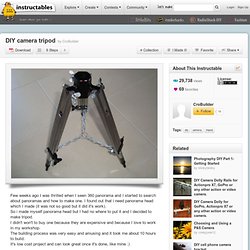

DIY Diffusion Panels For Less Than $30. ESTATIVO, SLIDER Y GRÚA CASEROS (DIY) HD Canon. Cómo construir GRÚA+SOPORTE DE HOMBRO para Cine (60 euros) Como hacer SOPORTE para T3i por menos de 20 dlls: Tutorial (español) DYI. Como hacer una dolly - How to make a camera dolly. Dolly casera por 15 euros.flv. Exel Composites – Advanced Pultrusion and Pullwinding Technologies. DIY (Hazlo tu mismo) DIY camera tripod. Few weeks ago I was thrilled when I seen 360 panorama and I started to search about panoramas and how to make one.

I found out that i need panorama head which I made (it was not so good but it did it's work). So i made myself panorama head but I had no where to put it and I decided to make tripod. I didn't won't to buy one because they are expensive and because I love to work in my workshop. The building process was very easy and amusing and it took me about 10 hours to build. It's low cost project and can look great once it's done, like mine :) So let's say something about tripods. I apologize if I misspelled something, my english is not so good. The Boda Jib by Jeremy Sawatzky. We have been featured!

If you would like to read the stories, follow the links! Newsshooter Cinema 5D Cinescopophilia My name is Jeremy Sawatzky, A machinist and engineer from British Columbia Canada. This is where I ended up. I will try to make this long story short and sweet. What I have come up with is a product that I believe fills a hole in the market. SizeWeightSetup TimeRigidityCapacity I set out to remedy those obstacles with my jib. The Boda jib features a never before seen folding design utilizing precision CNC cut aircraft grade aluminum, stainless steel and carbon fiber components. Boda will utilize a 3/8 screw mount on the bottom of the fluid base to easily attach to any half ball or tripod head.
Boda uses a high grade stainless steel cable assembly. The end of the jib will utilize a 75mm bowl mount to allow mounting of tripod heads, half balls and pan-tilt heads. 22 DIY DSLR Camera Rigs. DSLR cameras have revolutionized the world of independent filmmaking.

One of the most attractive features is their relatively low cost, but once you starting adding rigs and other accessories that cost can go up quick. In an effort to expand your DSLR’s capabilities without shrinking your wallet we put together this DIY DSLR round-up for you. $20 DIY PVC SnorriCam A SnorriCam (also chestcam, bodymount camera, bodycam or bodymount) is a camera device that is rigged to the body of the actor, facing the actor directly, so when he walks, he does not appear to move, but everything around him does. A SnorriCam presents a dynamic point of view from the actor’s perspective, providing an unusual sense of vertigo for the viewer.
Here is a simple SnorriCam using PVC tubes. VIA: Tom Preska. DIY tripod mods. Con un poco de bricolaje doméstico podemos poner a la última un altavoz clásico. Creating Custom Cinema Lenses. If you’re used to shooting on a DSLR, odds are you probably own a few lenses that were created specifically for shooting pictures and not video.

These lenses usually have apertures that click and no grooves for mounting a follow focus. While normally we would have shied away from lenses like this, we recently came across an awesome video tutorial by Caleb Pike of DSLR Video Shooter that shows us how to take cheap/old photography lenses and convert them into high-end cine lenses. The process doesn’t take much time at all, and it’s a lot cheaper than going out and buying a normal cine lens. On DSLR Video Shooter he explained how he purchased and converted 3 Olympus OM lenses to Canon Cine Lenses for only $431. Compare that to the Rokinon 35mm Cine lens which goes for $549 on B&H and you can see that this could really help you save a lot of money in the long run. The tutorial is a little long but well worth a watch for anyone interested in DSLR cinematography. Best viewed full screen:
Projector Project. Official Hackaday Prize Entry.